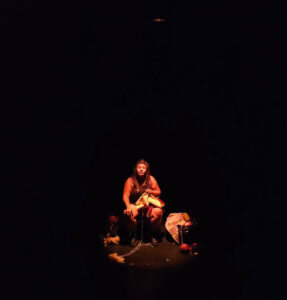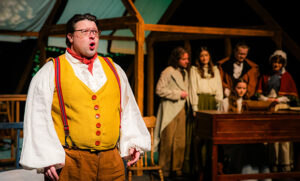I used to write stories compulsively as a child; I wrote hundreds and hundreds of them that fill vintage floppy disks and old coiled notebooks in my mother’s house. One of the things I used to do while in elementary school was write adaptations of classic stories, of fairytales mostly, where I clumsily tried to modernize them, and added awkward vernacular and borrowed jokes from Disney cartoons. Eventually, however, I realized that I was absent from these stories. They weren’t coming from my heart or my own inner truth. I wasn’t connected to any one of them. I was just trying to learn to be clever. I was reminded of these stories while watching Neptune’s Pre Professional Training Program’s production of The Ash Girl at the Studio Theatre last night.
The Ash Girl is Timberlake Wertenbaker’s 2000 adaptation of the Cinderella story. My first question is, I think, the obvious one. Do we really need ANOTHER adaptation of Cinderella? Why? This story sits in an awkward, hesitant place between being the familiar children’s tale we know and wanting to tread (awkwardly and hesitantly) into darker waters. It attempts to modernize aspects of the story only to have them appear oddly anachronistic. The footman, for example, could have been played as the Fresh Prince of Bel Air, but no one else seems to be anywhere remotely near Los Angeles. At the same time, the clarity of Wertenbaker’s choices is frustratingly ambiguous. She introduces her Prince (Amir) as being from some far away Arabian land without giving the audience any insight into why this is vital to the story, unless it is to reinforce the stereotypes of the allure of foreign kingdoms.
The biggest difference The Ash Girl provides when compared to other Cinderella stories is the allegorical incorporation of the seven deadly sins. In this play, it is suggested that the “Ash Girl” is struggling with some form of depression and serious self esteem problems. This could have been an interesting insight into the story, if the tools she is given weren’t so superficial. The Voice in the Mirror (this version’s Fairy Godmother) gives Ash Girl the same gifts Cinderella is given in the original: a pretty dress, killer shoes, and a chance to marry a Prince. I admit to my feminist biases, but those don’t sound like the shields I would want young girls to look to as defense against real issues of depression, self loathing, immense sadness or feelings of insecurity and inferiority.
Paradoxically, although fairytales are deceptively simple, I think that they provide some of the hardest work for actors. The members of the Pre Professional Training program work for sixteen hours a week from September until May and learn a variety of different theatrical skills. I think that this program is very important for the Nova Scotian theatre community, and a tool toward building knowledge and creating versatile performers, but I think there are definite limits to how much skill one can acquire in eight months. Ash Girl proved a difficult show for this company. When tackling fairytales, I think it is difficult to resist the urge to slip into imitations of stereotypes. It is especially difficult when the script relies heavily on stock characters rather than focusing on the specific, unique traits of individual human beings. Wertenbaker’s language provided even more challenges as it is utterly poetic (although inconsistent), but required actors who could find the truth in every word to make the poetry seamless and inconspicuous within the story. It is even more difficult to play an allegorical character, to personify a concept because concepts don’t have personalities or the same sort of depth as someone like Tennessee Williams’ Big Daddy Pollitt does. I also found myself wondering what the difference was between sloth, gluttony and envy; weren’t they, in essence, all different manifestations of the same principle?
The result was that The Ash Girl seemed a lot like the stories I wrote as a child, attempting at something someone else had done, but without deep, personal roots. I spent a few hours with members of the Pre Professional Training Program before seeing their show, and it is no doubt that they are an exuberant, versatile, talented bunch. I saw them do some slow motion fight choreography that had me mesmerized. I wish that Neptune would invest more in this program, it is, after all, the “only conservatory-style training program east of Montreal for adults.” I think that with more time, and more opportunities to do a variety of different theatre shows, the Pre Professional Training Program could become the foundation for emerging professional actors that I know the theatre school would like it to be. I think this requires that the actors are given the opportunity to play roles that they would feasibly be cast in at a Festival like Stratford, or Shaw, or in a company like Soulpepper; a Tennessee Williams, a Judith Thompson, a Samuel Beckett or Morris Panych play.
There was something hesitant about The Ash Girl and I feel like these performers needed someone to look at them square in the eye and say, “Here. This is a complex, deep, profound, renowned piece of world theatre to sink your teeth into. You’re going to do it and you’re going to be brilliant.” The last thing a young actor needs is to be able to get away with being wishy-washy. The theatre world can be as dark, twisty, and scary as the woods in any fairytale. You need to commit to your choices boldly from the get-go, or else you’re apt to get eaten by the wolf.
The Ash Girl is Timberlake Wertenbaker’s 2000 adaptation of the Cinderella story. My first question is, I think, the obvious one. Do we really need ANOTHER adaptation of Cinderella? Why? This story sits in an awkward, hesitant place between being the familiar children’s tale we know and wanting to tread (awkwardly and hesitantly) into darker waters. It attempts to modernize aspects of the story only to have them appear oddly anachronistic. The footman, for example, could have been played as the Fresh Prince of Bel Air, but no one else seems to be anywhere remotely near Los Angeles. At the same time, the clarity of Wertenbaker’s choices is frustratingly ambiguous. She introduces her Prince (Amir) as being from some far away Arabian land without giving the audience any insight into why this is vital to the story, unless it is to reinforce the stereotypes of the allure of foreign kingdoms.
The biggest difference The Ash Girl provides when compared to other Cinderella stories is the allegorical incorporation of the seven deadly sins. In this play, it is suggested that the “Ash Girl” is struggling with some form of depression and serious self esteem problems. This could have been an interesting insight into the story, if the tools she is given weren’t so superficial. The Voice in the Mirror (this version’s Fairy Godmother) gives Ash Girl the same gifts Cinderella is given in the original: a pretty dress, killer shoes, and a chance to marry a Prince. I admit to my feminist biases, but those don’t sound like the shields I would want young girls to look to as defense against real issues of depression, self loathing, immense sadness or feelings of insecurity and inferiority.
Paradoxically, although fairytales are deceptively simple, I think that they provide some of the hardest work for actors. The members of the Pre Professional Training program work for sixteen hours a week from September until May and learn a variety of different theatrical skills. I think that this program is very important for the Nova Scotian theatre community, and a tool toward building knowledge and creating versatile performers, but I think there are definite limits to how much skill one can acquire in eight months. Ash Girl proved a difficult show for this company. When tackling fairytales, I think it is difficult to resist the urge to slip into imitations of stereotypes. It is especially difficult when the script relies heavily on stock characters rather than focusing on the specific, unique traits of individual human beings. Wertenbaker’s language provided even more challenges as it is utterly poetic (although inconsistent), but required actors who could find the truth in every word to make the poetry seamless and inconspicuous within the story. It is even more difficult to play an allegorical character, to personify a concept because concepts don’t have personalities or the same sort of depth as someone like Tennessee Williams’ Big Daddy Pollitt does. I also found myself wondering what the difference was between sloth, gluttony and envy; weren’t they, in essence, all different manifestations of the same principle?
The result was that The Ash Girl seemed a lot like the stories I wrote as a child, attempting at something someone else had done, but without deep, personal roots. I spent a few hours with members of the Pre Professional Training Program before seeing their show, and it is no doubt that they are an exuberant, versatile, talented bunch. I saw them do some slow motion fight choreography that had me mesmerized. I wish that Neptune would invest more in this program, it is, after all, the “only conservatory-style training program east of Montreal for adults.” I think that with more time, and more opportunities to do a variety of different theatre shows, the Pre Professional Training Program could become the foundation for emerging professional actors that I know the theatre school would like it to be. I think this requires that the actors are given the opportunity to play roles that they would feasibly be cast in at a Festival like Stratford, or Shaw, or in a company like Soulpepper; a Tennessee Williams, a Judith Thompson, a Samuel Beckett or Morris Panych play.
There was something hesitant about The Ash Girl and I feel like these performers needed someone to look at them square in the eye and say, “Here. This is a complex, deep, profound, renowned piece of world theatre to sink your teeth into. You’re going to do it and you’re going to be brilliant.” The last thing a young actor needs is to be able to get away with being wishy-washy. The theatre world can be as dark, twisty, and scary as the woods in any fairytale. You need to commit to your choices boldly from the get-go, or else you’re apt to get eaten by the wolf.






